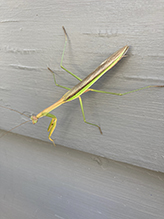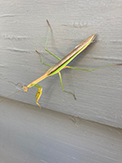Minnesota Praying Mantises
Mantodea is the order of insects known as praying mantises or mantids. The order was formerly classified as a suborder and placed within the order Orthoptera along with Walkingsticks; Cockroaches and Termites; and Grasshoppers, Crickets, and Katydids.
Sources differ, but the order Mantodea currently includes 14, 15, or 21 living and 2 extinct families, about 430 genera, and about 2,300 or more than 2,400 species worldwide. In North America north of Mexico there are just 20 species in 12 genera. Only two species are found in Minnesota. Both are non-native, introduced species.
Mantids are characterized by the large size, over one inch in total length; long, slender bodies; triangular heads; bulging compound eyes; short, thread-like antennae; flexible necks that allow them to look “over their shoulder”; greatly lengthened first segment of the thorax; and front legs adapted for grasping prey with the first segment greatly lengthened and the third and fourth segments armed with spines. The last part of the leg, corresponding to the foot, has five segments. The middle and hind legs are long and slender; have shorter first segments; and are used for walking, standing, and leaping. When they are stationary the posture is upright and the front legs are raised and folded, a stature that has led to the common name praying mantis. They lay eggs in a mass of foam that dries into an egg case with a papery outer shell. The eggs overwinter and hatch all at once in the spring.

Recent Additions

There are only two species of praying mantis in Minnesota, Chinese mantis and European mantis. Neither is native to North America. The most common by far is Chinese mantis (Tenodera sinensis sinensis). It is native to Japan, China, North and South Korea, Thailand, and Micronesia. It was accidentally introduced in Philadelphia in 1896. It is now common in the United States and southern Canada east of the Great Plains, in California west of the Rocky Mountains, and in most of Asia. It is uncommon in the southern third of Minnesota, where it is at the northwestern extent of its range, and is absent from the remainder of the state. It is found in grasslands, meadows, agricultural fields, and woodlands, and at the sides of streams and rivers.
Chinese mantis are large predaceous insects. They eat anything they can catch, including insects, small amphibians and reptiles, and hummingbirds. They remain stationary with their legs raised up as they wait for prey. Though they have wings, females do not fly. Males can fly only short distances. Adults are active in summer until fall, when they are killed by the first frost.
Chinese mantis is distinguished from European mantis by its larger size, the pattern of stripes and shape of plates on the face, a bold green stripe along the edge of the forewing, and a yellow spot between the front legs.
Other Recent Additions
This list includes only praying mantises that have been recorded in Minnesota, but not all of the praying mantises found in Minnesota.
| Profile | Photo | Video | |||
|---|---|---|---|---|---|
|
|||||
|
|||||
|
|||||
|
|||||
|
|||||
|
No Species Page Yet?
If you do not see a linked page for a species in the list at left you can still upload a photo or video or report a sighting for that species. Click on one of the buttons below and type in the common name and/or scientific name of the species in your photo, video, or sighting. A new page will be created for that species featuring your contribution.
These buttons not working for you?
Simply email us at info@MinnesotaSeasons.com.





